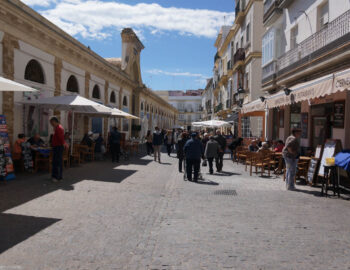Spain offers a wide variety of landscapes due to its diverse geography and climate. These are 10 of the different landscapes in Spain that you can see.
Personally, having lived in Gibraltar as a child from 8-10 years old and exploring Andalucia in southern Spain on most weekends with family, and visiting many other regions as an adult, the landscapes in Spain are some of my favourites.
Landscapes in Spain
1. Coastline

Spain’s Mediterranean coast boasts stunning beaches, crystal-clear waters, and picturesque coastal towns, such as the Costa Brava, Costa Blanca, and Costa del Sol, which make for some of the most famous and stunning landscapes in Spain.
Meanwhile, in southwest Spain, you have epic beaches like Tarifa Beach with its long stretch of sand and dunes. In the North of the country, there is a dramatic coastline with cliffs.
2. Mountain Ranges

Spain has some of the most beautiful mountains in Europe and some of the best landscapes in Spain are around the mountain ranges.
The Pyrenees mountain range forms a natural border between Spain and France, running along the northeastern part of the country. It is known for its stunning landscapes, and high peaks, and is popular for outdoor activities like hiking and skiing.
Located in the southern region of Andalusia, the Sierra Nevada is a prominent mountain range known for its snow-capped peaks, including Mulhacén, the highest point in mainland Spain. It is also home to a national park and a popular ski resort and is one of the most beautiful and famous landscapes in Spain.
Situated near Madrid, the Sierra de Guadarrama is a mountain range that offers hiking opportunities and stunning views of the surrounding countryside.
Found in the northern regions of Asturias, Cantabria, and Castile and León, the Picos de Europa is a rugged mountain range close to the northern coast of Spain. It is characterized by dramatic limestone peaks, deep valleys, and lush landscapes.
3. Green Landscapes

Northern Spain, particularly regions like Galicia, Asturias, and the Basque Country, is known for its lush green landscapes, rolling hills, and picturesque countryside, which makes for a difference in the landscapes in Spain that you would find in the south.
It offers some of the more known landscapes in Spain for hiking options in the region and the world-famous Camino de Santiago pilgrimage walk goes through the area.
For a different taste of Spain from other places head to the north.
4. Plateaus and Mesetas

The Meseta Central, often simply referred to as “La Meseta,” is a vast plateau located in the heart of Spain. It is one of the most significant geographical features of the country and covers a considerable portion of its central territory.
The Meseta Central is surrounded by different mountain ranges, which include the Pyrenees to the north, the Sistema Ibérico to the northeast, the Sistema Central to the east and south, and the Sierra Morena to the south.
The plateau has a relatively high elevation, ranging from 600 to 800 meters above sea level in most areas. While it is not as mountainous as the regions surrounding it, it still has some gentle undulations and occasional low mountain ranges.
The Meseta Central and the plateaus in Spain have a continental climate with hot summers and cold winters.
5. Deserts

Although not full-on deserts like the Sahara, Spain does have some arid semi-desert regions.
One of the most notable semi-arid regions in Spain is the southeastern part of the country, which includes parts of the provinces of Almería, Murcia, and Alicante. This area is known for its dry and desert-like landscapes, often referred to as the “Desert of Almeria” or the “Desert of Tabernas.” While not a true desert, it has been used as a filming location for many famous Western movies due to its arid appearance.
There is also the Bardenas Reales which was shaped by the erosion of the surrounding mountains over millions of years, resulting in an otherworldly environment filled with canyons, plateaus, and strange rock formations.
There are some volcanic regions in Spain with desert-like characteristics. The volcanic island of Lanzarote, part of the Canary Islands archipelago, has areas with a lunar-like landscape that can resemble a desert.
6. Wetlands

Spain is home to several important wetlands that provide critical habitats for various species of birds, fish, and other wildlife. These wetlands offer unique ecosystems and are often designated as protected areas to conserve their ecological importance.
The Donana National Park in Andalucia is a significant wetland area and a UNESCO World Heritage Site, attracting a rich diversity of bird species. It includes marshes, lagoons, and dunes, providing essential breeding grounds for numerous bird species, including flamingos and herons. The park is also a vital stopover for migratory birds.
Situated at the mouth of the Ebro River in northeastern Spain, the Ebro Delta is the largest wetland area in Catalonia. It comprises lagoons, rice fields, and sand dunes, attracting a wide variety of waterfowl, waders, and other bird species.
Tablas de Daimiel National Park is located in the Castile-La Mancha region, this wetland reserve consists of a series of oxbow lakes and floodplains. It is an essential habitat for water birds, especially during their migration.
Albufera of Valencia is rich in birdlife and supports traditional rice farming in the surrounding areas.
7. Volcanic Landscapes

Spain has several volcanic regions that make up some of the most dramatic landscapes in Spain and are primarily located in the Canary Islands and the Balearic Islands.
These volcanic areas have shaped the landscape and offer unique geological features for you to explore.
The Canary Islands, located off the northwest coast of Africa, have their own volcanic history and characteristics.
The largest and most populous Canary Island of Tenerife is home to Mount Teide, which is the highest peak in Spain and a dormant volcano. The Teide National Park surrounding the volcano is a UNESCO World Heritage Site and a popular tourist destination.
Lanzarote is known for its striking volcanic landscapes, including the Timanfaya National Park, which features vast lava fields, volcanic cones, and geothermal demonstrations.
Gran Canaria has several volcanic craters and valleys, and its landscapes have been shaped by volcanic activity over millions of years.
La Palma is considered the steepest island in the world, rising dramatically from the ocean due to volcanic activity.
Apart from the Canary Islands, there is one volcanic region on the Spanish mainland.
Garrotxa Volcanic Zone Natural Park: Located in Catalonia, near the city of Olot, is home to over 40 volcanic cones and numerous lava flows. It is a significant volcanic area on the Iberian Peninsula.
8. Islands

Spain is a country that includes various islands, each with its own unique culture, landscapes, and attractions.
The Canary Islands as mentioned before have some of the most varying landscapes in Spain.
The Balearic Islands are also some of the most popular islands in Spain with Mallorca being the largest, known for its beautiful beaches.
Menorca is Known for its more tranquil and laid-back atmosphere compared to Mallorca. Formentera is a small island known for its pristine beaches and clear waters.
Each of these islands offers a unique experience to visitors, from lush green landscapes in Spain to arid volcanic terrains and pristine beaches.
9. Caves and Caverns

Spain is home to numerous fascinating caves, some of which contain prehistoric cave paintings and unique geological formations.
The Altamira Cave, located in Cantabria, is one of the most famous prehistoric cave art sites in the world. It houses ancient paintings dating back to the Upper Paleolithic period, including realistic depictions of bison, horses, and other animals.
The Caves of Drach are situated on the island of Mallorca and are known for their stunning stalactites and stalagmites. The caves also contain Lake Martel, one of the largest underground lakes in the world.
The Nerja Caves are in the province of Malaga and are also renowned for their impressive stalactites and stalagmites. These caves also contain evidence of prehistoric human habitation.
Cueva del Viento (Cave of the Wind) is situated on the island of Tenerife and is one of the longest lava tubes in the world, formed by ancient volcanic activity.
There are so many other caves in Spain for you to explore, these are just some of the more notable ones.
10. Vineyards and Olive Groves

Spain is renowned for its diverse wine regions and vineyards that make up some of the more famous images of the landscapes in Spain. The regions produce a wide variety of high-quality wines.
The country’s climate and topography create ideal conditions for grape cultivation, making Spain the third-largest wine-producing country in the world. These are some of the most notable wine regions and vineyards in Spain.
La Rioja in northern Spain is perhaps the most famous wine region in the country. It produces some of Spain’s most exceptional and traditional red wines, predominantly made from the Tempranillo grape variety.
Ribera del Duero is situated along the Duero River in the Castilla y León region, Ribera del Duero is known for its powerful and robust red wines, primarily made from the Tinto Fino (a local variant of Tempranillo) grape.
Jerez in the Andalusia region is famous for producing Sherry, a fortified wine with various styles ranging from dry to sweet. The unique climate of the region contributes to the development of the distinctive flavours of Sherry.
Travel Spain

These landscapes in Spain not only provide breathtaking scenery but also contribute to Spain’s rich biodiversity and cultural heritage.
Each region offers a unique experience and adds to the charm of this beautiful country.
For more on travel in Spain take a look at 10 of the best weekend breaks in Spain, that cover many of the landscapes mentioned here.
Share the landscapes in Spain:





